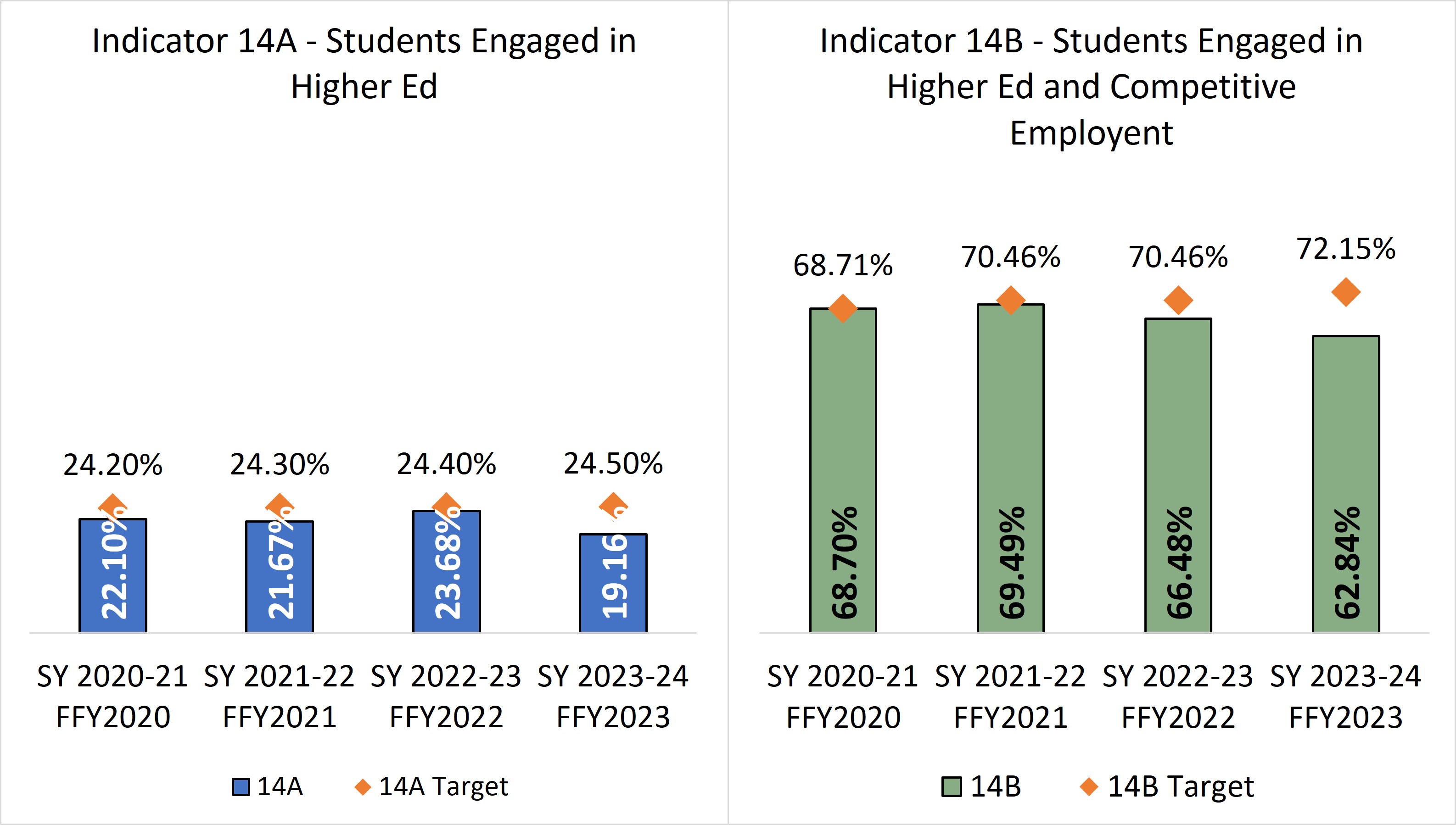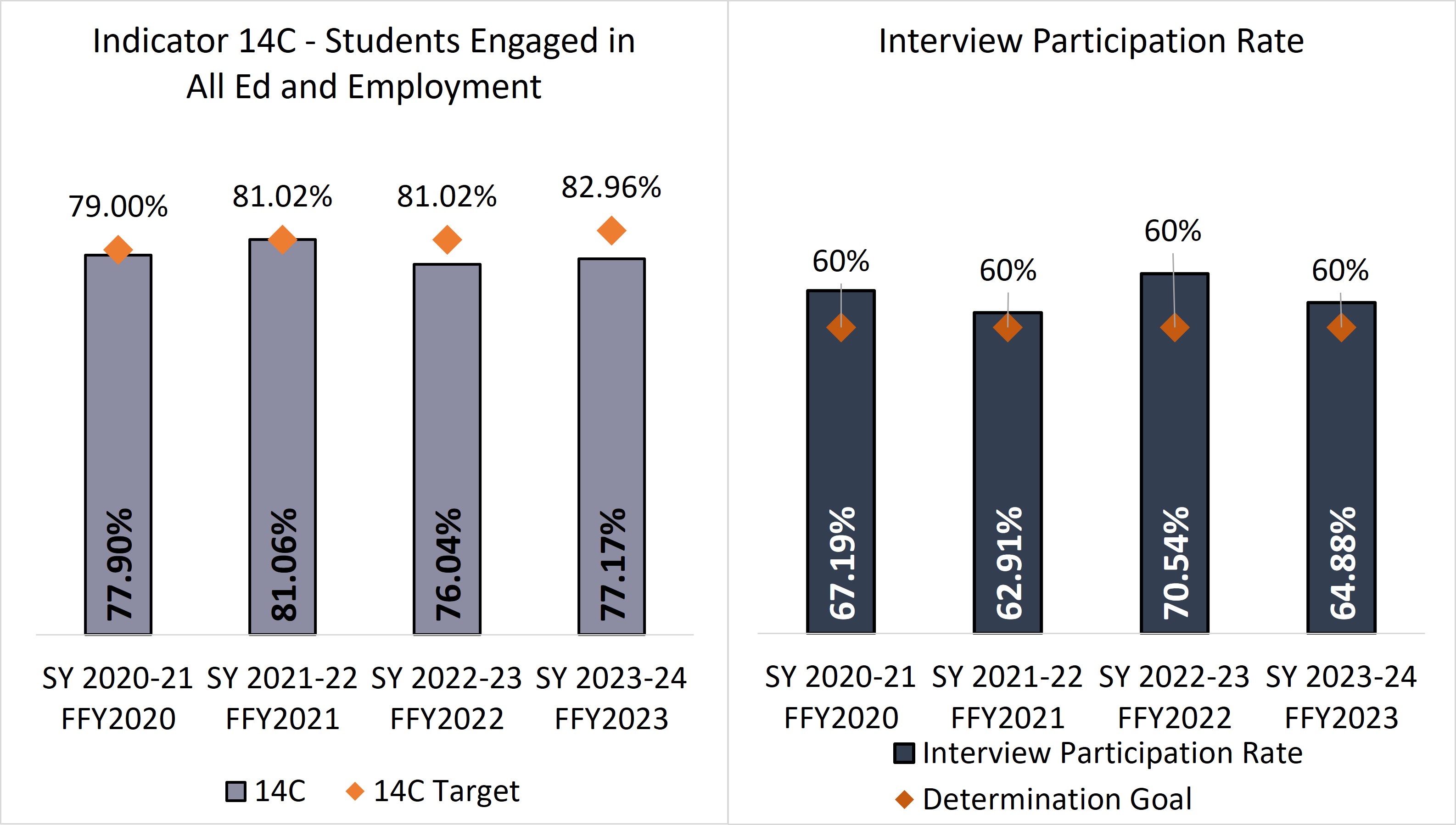You are here
Indicator 14 - Post-School Outcomes
SY2024-25 Post School Outcome Collection in DMS
- Post School Outcomes Collection in DMS Training 2024-25 (PowerPoint)
- 2025 Colorado Current PSO Interview Protocol (PDF)
- Demystifying the PSO Interview Process (PDF)
For additional PSO and Indicator 14 educator resources, visit the Secondary Transition page
Definition
Percent of youth who are no longer in secondary school, had IEPs in effect at the time they left school, and were:
- Indicator 14A. Enrolled in higher education within one year of leaving high school.
- Indicator 14B. Enrolled in higher education or competitively employed within one year of leaving high school.
- Indicator 14C. Enrolled in higher education or in some other postsecondary education or training program; or competitively employed or in some other employment within one year of leaving high school.
Measurement
Indicator 14A. Percent enrolled in higher education = [(# of youth who are no longer in secondary school, had IEPs in effect at the time they left school and were enrolled in higher education within one year of leaving high school) divided by the (# of respondent youth who are no longer in secondary school and had IEPs in effect at the time they left school)] times 100.
Indicator 14B. Percent enrolled in higher education or competitively employed within one year of leaving high school = [(# of youth who are no longer in secondary school, had IEPs in effect at the time they left school and were enrolled in higher education or competitively employed within one year of leaving high school) divided by the (# of respondent youth who are no longer in secondary school and had IEPs in effect at the time they left school)] times 100.
Indicator 14C. Percent enrolled in higher education, or in some other postsecondary education or training program; or competitively employed or in some other employment = [(# of youth who are no longer in secondary school, had IEPs in effect at the time they left school and were enrolled in higher education, or in some other postsecondary education or training program; or competitively employed or in some other employment) divided by the (# of respondent youth who are no longer in secondary school and had IEPs in effect at the time they left school)] times 100.
Every summer, Administrative Units conduct post-school interviews with former high school students who had IEPs in effect at the time they left school during the previous school year. The data collection opens in June and closes in September.
How is Colorado doing on this indicator?
Targets for the Current SPP/APR Cycle
| Federal Fiscal Year (FFY) | 2020 | 2021 | 2022 | 2023 | 2024 | 2025 |
| Data from School Year | 2020-21 | 2021-22 | 2022-23 | 2023-24 | 2024-25 | 2025-26 |
| Target A >= | 24.20% | 24.30% | 24.40% | 24.50% | 24.60% | 24.70% |
| Target B >= | 68.71% | 70.46% | 70.46% | 72.15% | 72.15% | 73.76% |
| Target C >= | 79.00% | 81.02% | 81.02% | 82.96% | 82.96% | 84.81% |
Improvement Strategies for Transition Age Students (Indicators 1, 2, and 14)

- Sequencing of Services Framework
- A multi-agency team has developed a sequencing of services framework to clarify student outcomes from junior high through age 24 and to identify the role of each stakeholder (families, community-centered boards, division of vocational rehabilitation, etc.) in assisting students to meet defined outcomes.
- Capstone Projects
- CDE established a Capstone workgroup to build school district personnel’s knowledge of how to develop capstones aligned with school district graduation requirements for students with significant needs.
- Equity work
- CDE/DVR/Colorado Community College System (CCCS) offers professional learning opportunities to school district personnel to assure equitable access of students with disabilities access to CTE programs (5-year project – 2021-2026):
- CDE will partner with AUs with the highest need, identified through a review of data, to improve dropout and graduation rates, and post-school outcomes.
- Training and Technical Assistance
- Person-centered planning for students with disabilities, online, in-person, and Moodle course
- 10 transition training modules to address needs for families and school district personnel
- CDE provides opportunities for LEAs to engage in post-school outcomes data discussions to identify strengths in current practices and opportunities to improve response rates
- CDE offers statewide regional trainings on a variety of transition topics
- CDE hosts a statewide conference, the Transition Leadership Institute, each year to build LEA knowledge of evidence-based secondary transition practices
- Components of secondary transition planning
Improvement Strategies
The feedback period has closed, and this video is included for information on the target-setting process (the Indicator 14 section starts at 00:06:56).
For more information, contact:
Orla Bolger
Supervisor, Data and Monitoring Liaison
Email Orla Bolger
Phone: (720) 921-0524
Josh Fails
Online Project Coordinator (DMS) & Data Consultant
Email Josh Fails
Phone: (720) 618-0538
Having trouble with this webpage?
If you have problems with broken links or accessing the content on this page, please contact the Exceptional Student Services Unit at ESSU@cde.state.co.us. Please copy the URL link for this page into the email when referencing the problem you are experiencing.




Connect With Us





